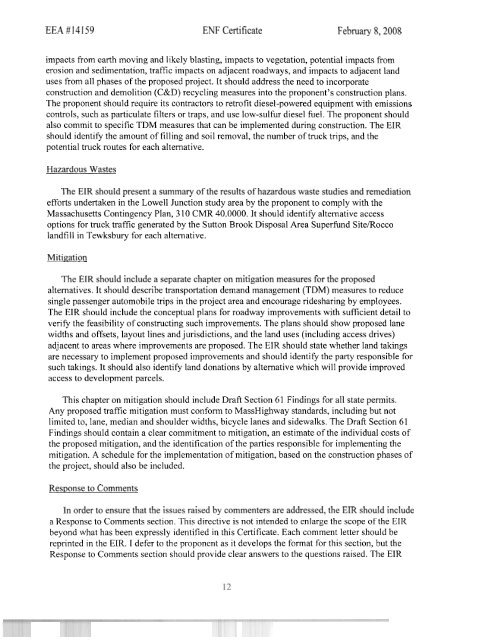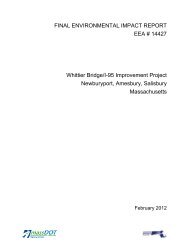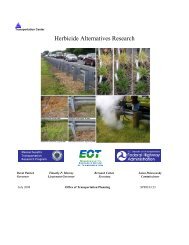MEPA certificate - I-93 Tri-Town Interchange Project - Executive ...
MEPA certificate - I-93 Tri-Town Interchange Project - Executive ...
MEPA certificate - I-93 Tri-Town Interchange Project - Executive ...
Create successful ePaper yourself
Turn your PDF publications into a flip-book with our unique Google optimized e-Paper software.
EEA #I4159 ENF Certificate February 8,2008<br />
impacts from earth moving and likely blasting, impacts to vegetation, potential impacts from<br />
erosion and sedimentation, traffic impacts on adjacent roadways, and impacts to adjacent land<br />
uses from all phases of the proposed project. It should address the need to incorporate<br />
construction and demolition (C&D) recycling measures into the proponent's construction plans.<br />
The proponent should require its contractors to retrofit diesel-powered equipment with emissions<br />
controls, such as particulate filters or traps, and use low-sulfur diesel fbel. The proponent should<br />
also commit to specific TDM measures that can be implemented during construction. The EIR<br />
should identify the amount of filling and soil removal, the number of truck trips, and the<br />
potential truck routes for each alternative.<br />
Hazardous Wastes<br />
The EIR should present a summary of the results of hazardous waste studies and remediation<br />
efforts undertaken in the Lowell Junction study area by the proponent to comply with the<br />
Massachusetts Contingency Plan, 3 10 CMR 40.0000. It should identify alternative access<br />
options for truck traffic generated by the Sutton Brook Disposal Area Superfiind SiteIRocco<br />
landfill in Tewksbury for each alternative.<br />
Mitigation<br />
The EIR should include a separate chapter on mitigation measures for the proposed<br />
alternatives. It should describe transportation demand management (TDM) measures to reduce<br />
single passenger automobile trips in the project area and encourage ridesharing by employees.<br />
The EIR should include the conceptual plans for roadway improvements with sufficient detail to<br />
verify the feasibility of constructing such improvements. The plans should show proposed lane<br />
widths and offsets, layout lines and jurisdictions, and the land uses (including access drives)<br />
adjacent to areas where improvements are proposed. The EIR should state whether land takings<br />
are necessary to implement proposed improvements and should identify the party responsible for<br />
such takings. It should also identify land donations by alternative which will provide improved<br />
access to development parcels.<br />
This chapter on mitigation should include Draft Section 61 Findings for all state permits.<br />
Any proposed traffic mitigation must conform to MassHighway standards, including but not<br />
limited to, lane, median and shoulder widths, bicycle lanes and sidewalks. The Draft Section 61<br />
Findings should contain a clear commitment to mitigation, an estimate of the individual costs of<br />
the proposed mitigation, and the identification of the parties responsible for implementing the<br />
mitigation. A schedule for the implementation of mitigation, based on the construction phases of<br />
the project, should also be included.<br />
Response to Comments<br />
In order to ensure that the issues raised by commenters are addressed, the EIR should include<br />
a Response to Comments section. This directive is not intended to enlarge the scope of the EIR<br />
beyond what has been expressly identified in this Certificate. Each comment letter should be<br />
reprinted in the EIR. I defer to the proponent as it develops the format for this section, but the<br />
Response to Comments section should provide clear answers to the questions raised. The EIR
















